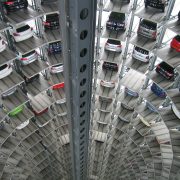LEED Parking: Can Green Parking Garages Be Certified?
LEED Certification and Parking Facilities: Reducing Environmental Footprints
Leadership in Energy and Environmental Design (LEED) certification is part of a nationwide green construction program that grants accreditation to buildings and facilities that meet demanding energy efficiency and ecological standards. Earlier in LEED’s history, there was ongoing debate as to whether or not green parking garages, as standalone structures, could qualify for LEED certification. The long and short of it boils down to this: parking facilities by themselves cannot be certified under the LEED program, but they can incorporate features that help the building, as a whole, earn certification.
In addition, after the LEED decision, a new organization and new certification arose: the Green Parking Council and Green Garage Certification, recently renamed Parksmart. To make things even more confusing, Green Building Certification, Inc., which manages LEED certification for the USGBC, now manages Parksmart certification, too. So yes, green parking garages can be certified, just not LEED certified.
Technicalities and certifications aside, there are plenty of ways to “go green” by improving energy efficiency and reducing the environmental footprint of parking facilities. Lighting systems, parking priorities, construction materials and ventilation systems can all be configured to support green initiatives.
The Impact of Efficient Lighting
While parking structures themselves may not be eligible for LEED certification, they can take part in the U.S. Energy Department’s Lighting Energy Efficiency in Parking (LEEP) initiative. When the campaign went widespread in 2014, participating partners were able to cut lighting-related energy use by a whopping 90 percent.
The program encourages parking garages to switch to energy-efficient options like fluorescent, halide and LED-powered systems. It also promotes technologies that offer better control over light activation and deactivation, ensuring energy isn’t being wasted when the facility isn’t in use.
Special Access for Drivers of Efficient Vehicles
Another strategy that’s been used in traffic-heavy areas like Southern California is to give priority access to drivers of fuel-efficient hybrid or electric vehicles. Giving these vehicles access to the most conveniently located spots raises awareness of ecological issues and rewards drivers who are doing their part to reduce carbon emissions.
Getting Creative with Construction Materials
Paul de Ruiter Architects, a Dutch building design firm, recently made waves with a bold approach to parking structure construction. The firm created a garage made completely of recyclable materials, and engineered it so it could be dismantled in the future, when sustainable modes of transportation have become the standard and dedicated parking space for cars is no longer needed.
De Ruiter’s building, known as the Mors Gate garage, also uses natural ventilation, heat recovery systems and other advanced green technologies, leading some to hail it as a new standard in parking structure design. Even though a “future without cars” is still a long way off, innovation remains a powerful weapon in the fight against pollution.
Reducing Demand
While parking facilities themselves may not be eligible for LEED, one step toward certification for your building can include reducing the number of parking spaces you offer. How can this be justified? By reducing demand. TDM programs and software like RideAmigos can have an incredible effect on shifting the way people think about and use transportation, particularly for commuting. Contact us to learn more about how your organization can reduce its parking and environmental footprints and help transform transportation.










Leave a Reply
Want to join the discussion?Feel free to contribute!